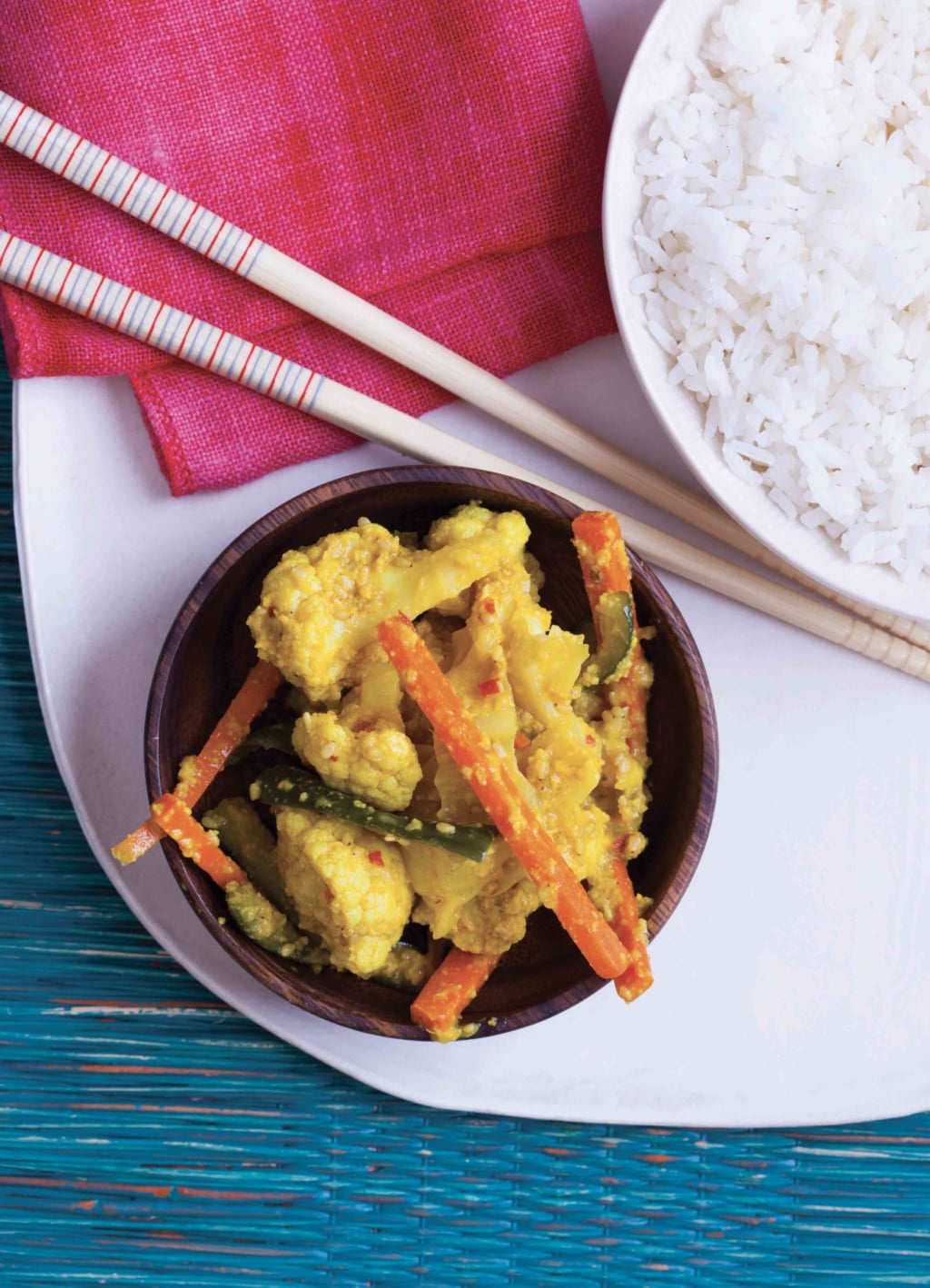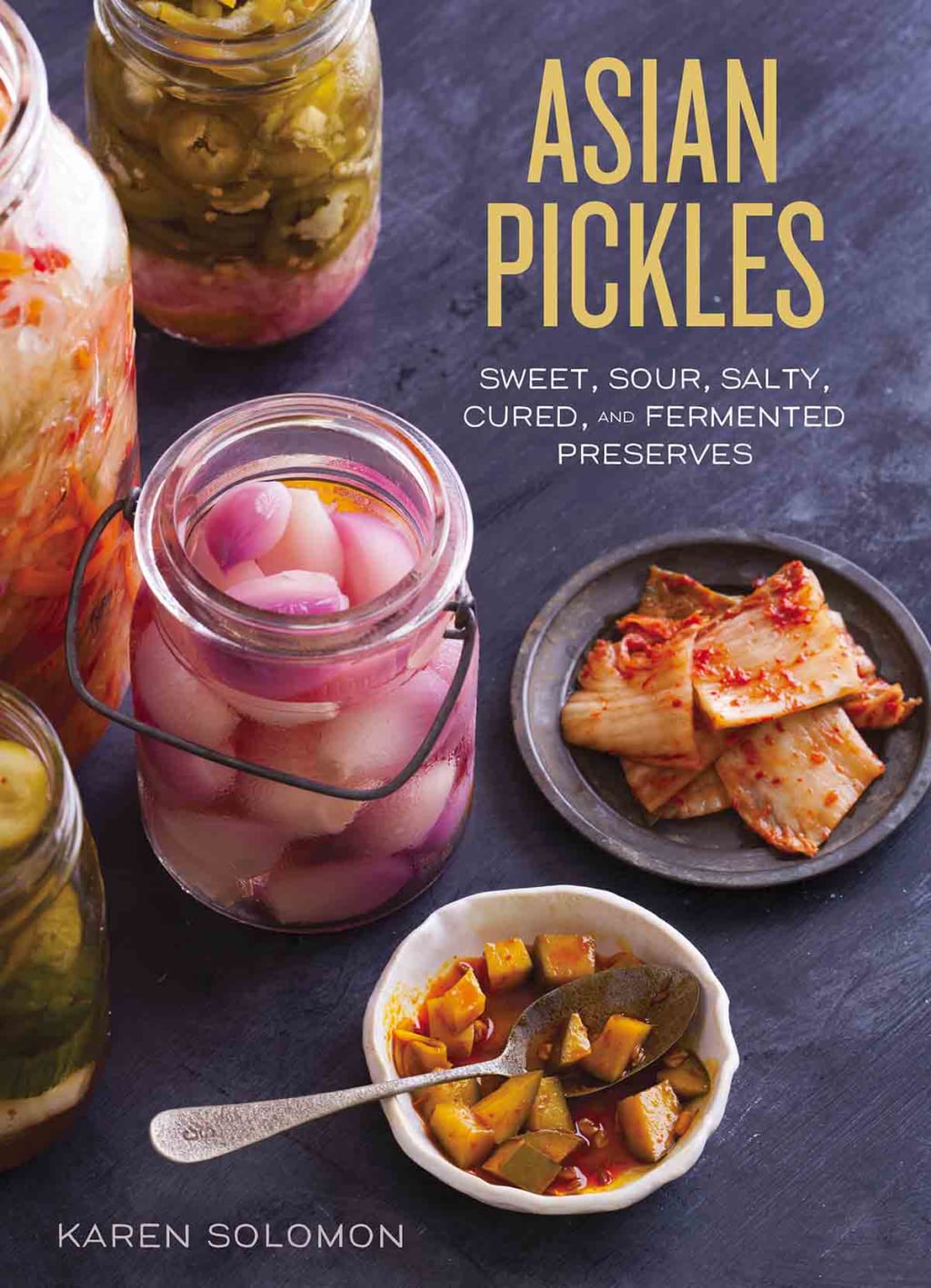Recipe for Spicy Pickled Vegetables by Karen Solomon
The chef shares the recipe for a particularly spicy pickled vegetable dish that combines sweet, salty, spicy, and bitter flavours.

© 2014 by Jennifer Martiné
In her book Asian Pickles, Karen Solomon shares the recipe for a pickled vegetable dish to be eaten either as an accompaniment to meat or a simple meal, with a bowl of rice. This recipe combines several flavours: sweet, spicy, salty, and bitter.
The preparation process is a little complex but worth the effort, the chef explains in her introduction. ‘I promise you that your Herculean efforts—blanching and dehydrating the vegetables, mixing the spiced paste, making the brine—will result in a dish you can be proud of and, above all, will launch your career as a pickler in your own home!’
This spicy pickled vegetable dish leaves the individual chef lots of room for manoeuvre. Some people will decide against including cauliflower and pineapple, considering them to be ‘inauthentic’, Karen Solomon explains. The same goes for peanuts: some will mix them with sesame seeds, while others will just use peanut butter.
Pickles are one of the hallmarks of Asian cuisine. Asian Pickles, a book by Karen Solomon, offers over 75 recipes using these marinated vegetables, made using a variety of ingredients, for novices and more competent cooks alike.
Makes 8 portions
Ingredients
1.5 l water
1 tablespoon plus 1 teaspoon kosher salt
1 tablespoon sugar
440 ml distilled white vinegar
240 g Persian cucumbers, ends trimmed or scrubbed and julienned
340 g chopped pineapple, in 2.5-cm cubes
170 g cut green beans, trimmed and chopped into 2.5-cm pieces
675 g chopped cauliflower, in 1.25-cm cubes
150 g carrots, peeled and julienned
675 g green cabbage, quartered, cored, and cut into 2.5-cm strips
5 cloves garlic, peeled
1 7.5-cm piece peeled fresh turmeric
1 5-cm piece peeled fresh ginger, coarseley chopped
2 large jalapeño chillies, stemmed
7 small dried red chilli peppers
150 g raw peanuts
90 g shallots
1 tablespoon anchovy paste
2 tablespoons peanut or vegetable oil
225 g packed brown sugar
225 g toasted white sesame seeds
Method
In a medium Dutch oven or other heavy-bottomed pot, combine the water with the tablespoon of salt, the sugar, and 250 ml vinegar and bring to a boil over high heat.
Combine the cucumbers with the remaining teaspoon of salt in a small mixing bowl. Toss with your hands to distribute the salt and set aside for 15 minutes, tossing once halfway through. After they’ve started to sweat their liquid, drain the cucumbers well and place them into the centre of a clean kitchen towel. Bring the four corners of the towel together and, over the sink, twist it to squeeze the cucumbers and remove as much moisture as possible. Set the cucumbers aside.
When the seasoned water comes to a boil, lightly boil the vegetables and fruit one at a time, so as not to crowd the pot. First add the pineapple to the pot, cover, and boil for two minutes; remove with a slotted spoon and transfer to a large colander in the sink. Run cold water over it to stop the cooking process. Next, boil the beans in the same way for two minutes before adding them to the pineapple and rinsing to cool; then cook the cauliflower for two minutes, and then the carrots for one minute, adding each to the colander and rinsing to stop the cooking process. Then cook the cabbage for two minutes, uncovered this time; stir it continuously, as there will be a lot to fit into the pot. Transfer the cabbage to the colander with a slotted spoon and rinse it, along with all of the other vegetables, under cold running water to stop the cooking process. Pour about 250 ml of the hot liquid into another vessel and discard the rest or save it for soup stock. Set the pot aside; you’re going to use it again.
Drain the vegetables in the colander very well, stirring them with your hands to combine and to coax out as much water as you can. Combine the squeezed cucumbers with the vegetables, then divide the vegetables between two large kitchen towels; roll up the towels and squeeze gently to help dry off the vegetables.
Preheat the oven to 90°C with the racks in the middle. Divide the vegetables between two large, rimmed baking sheets and transfer them into the oven to dry. Keep the oven door a little ajar, wedging it open with the handle of a wooden spoon if necessary, allowing moisture to escape. Dry the vegetables for about 1 1⁄2 hours, stirring them once halfway through, until they are dry to the touch. Note that if you have access to hot, direct sunlight, you can dry the vegetables in the sun instead.
While the vegetables dry, make the spice paste. In a food processor, combine the garlic, turmeric, ginger, jalapeños, dried chillis, peanuts, shallots, and anchovy paste and process into a paste, scraping down the sides as necessary. When the paste is smooth, stream in the oil with the machine running and process until fully incorporated.
Scrape the spice paste into the dry Dutch oven and set it over medium heat. Cook the paste for about ten minutes, scraping the bottom of the pot with a heavy wooden spoon, until it dries, becomes fragrant, and darkens somewhat. Add the brown sugar, the remaining vinegar, and the 250 ml of reserved boiling liquid from the vegetables. Stir to combine, cover, remove from the heat, and set this brine aside until the vegetables are dried. Add all of the vegetables to the brine (it should still be warm) and stir well to combine, then stir in the sesame seeds.
Let the pickle sit at room temperature for about four hours, then pack into covered glass or ceramic containers (plastic may retain its odours) and refrigerate. This pickle will keep for at least three weeks.
Asian Pickles (2014), a recipe book by Karen Solomon, is published by Ten Speed Press, and is currently only available in English.
Alongside recipes, the book contains various explanations about this south-Asian pickling culture, and offers simple but astute tips for those interested in trying their hand at this food-preservation method on a long-term basis.
Karen Solomon is a food writer and culinary instructor. She specialises in the different methods of food preservation: making preserves, canning, drying, and smoking. Asian Pickles is her third book after Can It, Bottle It, Smoke It and Jam It, Pickle It, Cure It.
“Reprinted with permission from Asian Pickles: SWEET, SOUR, SALTY, CURED, AND FERMENTED PRESERVES FROM KOREA, JAPAN, CHINA, INDIA, AND BEYOND by Karen Solomon. Copyright © 2014. Photographs copyright © 2014 by Jennifer Martiné. Published by Ten Speed Press, an imprint of Penguin Random House.”

© 2014 by Jennifer Martiné
TRENDING
-
Ishiuchi Miyako, A Singular Perspective on Women
Recipient of the 2024 Women in Motion Award, the photographer creates intimate portraits of women through the objects they left behind.

-
Recipe for Ichiraku Ramen from ‘Naruto’ by Danielle Baghernejad
Taken from the popular manga with the character of the same name who loves ramen, this dish is named after the hero's favourite restaurant.

-
Namio Harukawa, Master of Japanese SM Art
'Garden of Domina' offers a dive into the world of an icon of ‘oshiri’, whose work has now reached a global audience.

-
The Tattoos that Marked the Criminals of the Edo Period
Traditional tattoos were strong signifiers; murderers had head tattoos, while theft might result in an arm tattoo.

-
The Emperor of Japanese Porn is Now the Star of a Netflix Series
Deliciously funny, The Naked Director especially succeeds in reviving the atmosphere that was so characteristic of 1980s Japan.





